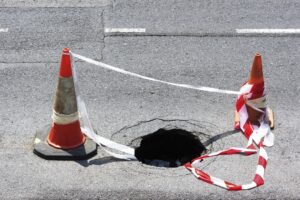There have been a lot of reports lately in the news from around the country about sinkholes. These holes in the ground that seem to appear out of nowhere and swallow up streets, sidewalks, and parking lots are both scary and mystifying. The short explanation is that they result from voids that form under the ground’s surface. Not all voids become sinkholes, but all sinkholes were once a void. And voids, both large and small, can pose a threat when you are working on or with concrete. Luckily, there are tools and skills that can be used to find concrete voids. Read on to learn how to locate concrete voids and repair them once you find them.
Locating Concrete Voids
Visual examination is the primary way that many (and perhaps even most) voids are discovered. Changes in the yard’s surface, specifically sunken or depressed areas, are the most significant visual signs of void under the surface. If the void is beneath concrete, the changes will take a long time to be visible and may be less noticeable. In a dirt surface, where a void might cause a large part of the ground to sink slightly under a concrete slab, it may start out as just cracks.
The other way that voids are often found is with ground-penetrating radar. Ground penetrating radar uses radar signals that are sent downwards into the ground to determine what is happening under the surface based on how the radar bounces back and is received by the device. Ground penetrating radar has been used for a long time for forensic applications, but it is also used daily for mundane applications. Ground penetrating radar can be used to find buried utilities, metal, and even voids underground.
Fixing Concrete Voids
If the void was discovered through simple visual examination, then it is time to bring in the ground-penetrating radar equipment as described above. A professional using ground-penetrating radar can determine the specifics of the void before anyone ever tries to get to it. Once you know exactly where, how deep, and how wide the void is, your team of professionals can get to it and work on filling it or otherwise ensure that it doesn’t get any larger and cause a cave-in. This is not a job that a homeowner should ever undertake – it is work that should be done by a professional.
Concrete Visions Will Get The Job Done Right
Concrete Visions has been working with clients for over 25 years. Our G&M Services installers are certified with the industry’s major firestop product manufacturers. As part of our firestop service, we can assess abnormal field conditions and, with the manufacturer’s technical support assistance, provide engineering judgments in a timely fashion to comply with contract specifications. Our Field Mechanics undergo ongoing training, including mandatory monthly safety meetings, weekly Toolbox Talks where safety and equipment information is shared, and training on safe work standards and safety best practices.

